The Doge’s Palace was not only the residence of the ruler of Venice but also the seat of government. There are many things to see at the Doge’s Palace, but how do you know what to see when there? This guide will make sure you hit all the main spots without wandering around all day.
Pro Tip: Planning what to do on your trip to Venice? Bookmark this post in your browser so you can easily find it when you’re in the city. See our guide to Venice for more planning resources, our top Doge’s Palace tours for a memorable trip, and how to visit the Doge’s Palace.
What To See at the Doge’s Palace
The Doge’s Palace has an extensive history and there are a few main areas you must see when you visit. From dark to opulent, we’ll also take a look at how it affected one of the most amazing republics of Italy throughout the centuries. Starting from the entrance of this Gothic beauty, here are the top things to see at the Doge’s Palace.

Watch this video on YouTube
Not ready to book a tour? Check out our Doge’s Palace Guide for more info.
9. Scala Dei Giganti
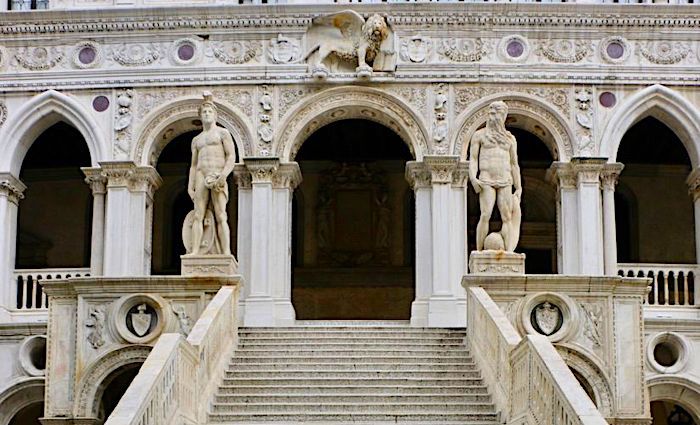

When you enter the Doge’s Palace, you’ll find yourself in a courtyard. There, you’ll see the Scala dei Giganti. The staircase leads up to the staterooms on the first floor. Work started on the staircase after the fire of 1483, which destroyed parts of the Ducal Palace.
Historically, this staircase is quite important. For many centuries, the coronation ceremonies of newly elected doges took place at the top of the staircase in the gallery.
There are two statues at the top of the stairs. One is of Poseidon to represent Venice’s coastal trade power. The other is Mars, symbolizing the political power of the trading empire. In between these two statues is the winged lion—the symbol of Venice’s patron saint, St. Mark.
Designed by the famous artist Jacopo Sansovino, the statues were placed in 1565. This marked the end of an 80-year renovation and was an example of the new Renaissance-style architecture.
8. Great Council Chamber
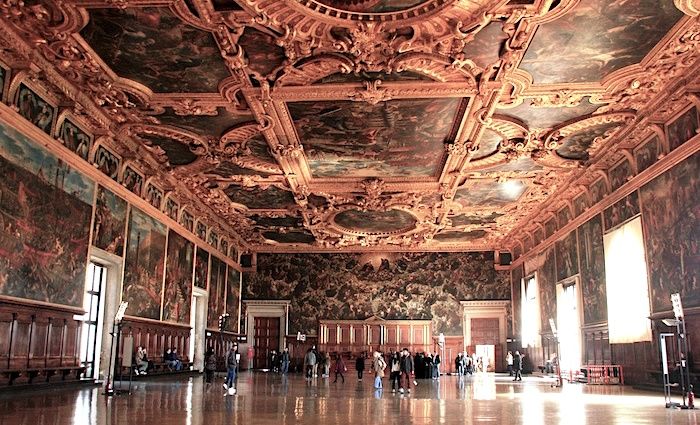

The Great Council Chamber inside the Doge’s Palace is one of the most amazing rooms you’ll see in Europe. Surrounded by astonishing pieces of art, the Senate deliberated and came to agreements on financial matters and other public concerns in this room. They also decided on the sentences for the prisoners held in the prison.
The council was made up of the male members of patrician Venetian families over 25 years old, regardless of their individual status, merits, or wealth. While not a democracy as we know it today, this system, which spanned over 1,000 years, created a very specific checks and balances system that avoided any one person having too much power, including the doge himself.
This room is also where the first phase of the election of a new doge would take place. The process was purposely long and intensive to discourage any kind of cheating taking place.
One of the artworks you’ll be able to admire in this room is Tintoretto’s Paradise. It is one of the largest oil paintings on canvas in history and represents heaven on earth. It is said that its purpose was to look over the council so they would make appropriate decisions.
7. Bridge Of Sighs
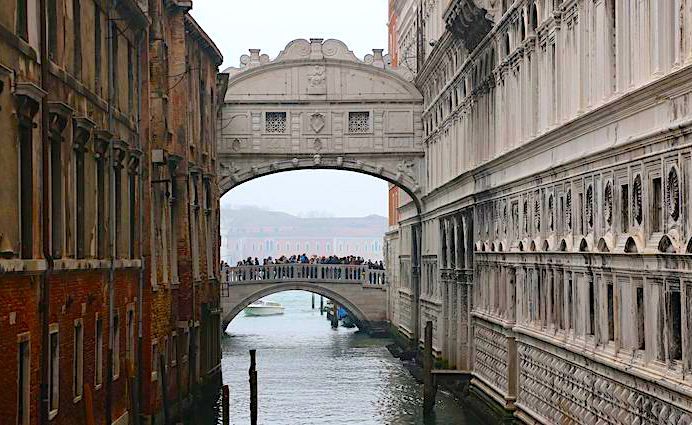

Another highlight of the Doge’s Palace is the Bridge of Sighs, which connects the Palace to its prison. At the end of the 16th century, the doge decided to house criminals in the next building over instead of in the main building.
Antonio Contino built the bridge in 1600. It is made from white limestone and is extremely ornamental. While most bridges in Venice are not covered, this bridge was covered and even had windows.
The name, Bridge of Sighs, comes from the Romantic Period and refers to the prisoners’ sighs. After being sentenced for their crimes in the palace, they would cross the bridge where they would get one last glimpse of the outside world. You can see the lagoon and San Giorgio through the very small windows there.
While the name was popular, it was finally immortalized when Lord Byron wrote about it in his 1812 book, “Childe Harold’s Pilgrimage.” The famous quote is, “I stood in Venice, on the Bridge of Sighs; a palace and a prison on each hand.”
Whether the story of the prisoners’ sighs is true or not, it’s certainly romantic. As one of the most romantic cities in the world, it’s very fitting to take a gondola ride under the Bridge of Sighs with your loved one at sunset. Especially, with the ringing of the St. Mark’s bell tower in the background.
Not ready to book a tour? Check out our article on the best Venice tours to take and why.
6. Chamber Of Torment
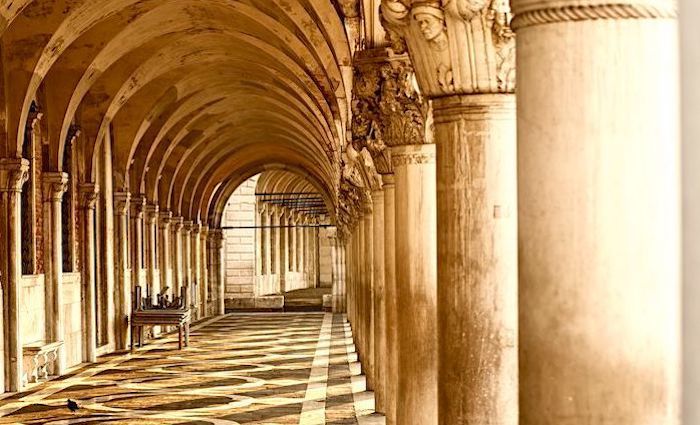

The Chamber of Torment was a dreaded place by the accused. Prisoners would wait in complete darkness before it was their turn to be questioned. All the while, they’d hear the painful screams of fellow inmates. These were often fake screams, however, by paid actors to terrorize the waiting prisoners.
Here, interrogations and torture took place. Criminals were pulled by their arms with rope while they were tied behind their backs. It’s a very painful position to be questioned in. This torture would continue until the prisoner confessed to the crime committed.
5. The Doge’s Apartments
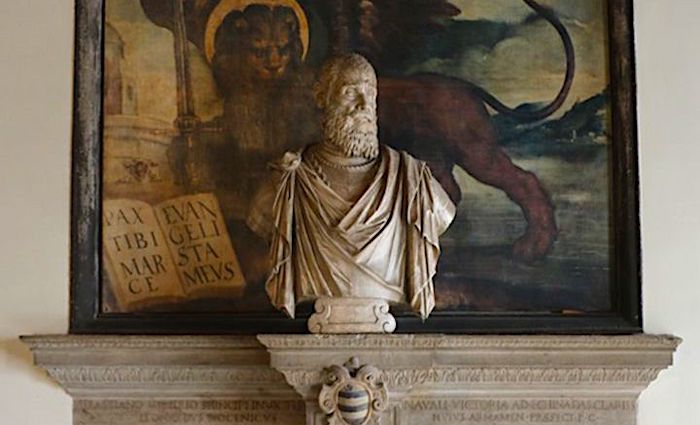

The doge has always resided in the palace itself. The rooms were always located between the present Golden Staircase and the apse of St. Mark’s Basilica, also called the Ducal Chapel.
The entire area was destroyed in a fire in 1483. The rooms were then rebuilt in the Renaissance style. What you see today comes from this period. The decor includes engraved wooden ceilings, huge marble chimneys, and delicately carved decorations with painting friezes and stuccoes.
Until the 17th century, the rooms where the doge resided were quite small. They were almost always smaller than what they’d been used to in private life. This was for the humility of the doge, as his first priority was the Republic of Venice.
The incoming doge would bring his furniture and other furnishings from his private residence. Upon his death, these furnishing would be removed by his next of kin to allow the incoming doge to bring his own personal belongings.
Today, the rooms you can visit have been outfitted with technology for more dynamic exhibitions while still highlighting their original decorations.
4. Prisons
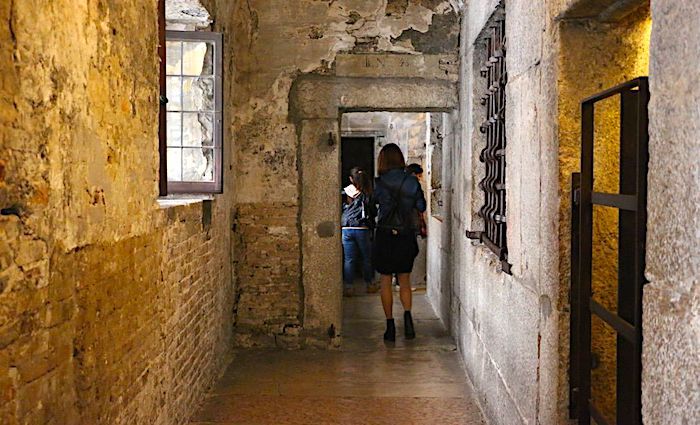

While the Doge’s Palace was the home of the doge himself, it also functioned as staterooms where all the leading men of the Republic came together to discuss state affairs. The palace was also used as a courthouse and prison.
There were two kinds of classifications for the prisons: Pozzi and Piombi. The pozzi, which means “wells” in Italian, was a detention place for prisoners—one of the worst to be in. As you can deduce from its name, these wet little cells were hardly ventilated and reeked. They were extremely miserable cells for prisoners.
In the mid-16th century, they decided to add another set of cells on the other side of the canal. To connect the two, they would build the famous Bridge of Sighs. The cells here were called piombi. They were created to provide better conditions for the prisoners. They had more light and more room overall. Only a few of the cells were actually done in this way since many of them were just interconnecting or overlooking the inner courtyard.
These cells were reserved for people who committed political crimes or who were serving short sentences. The famous Casanova was imprisoned in both types of cells for a period of time and he confirmed that the piombi was definitely a better place to be than the pozzi.
Not ready to book a tour? Check out our Doge’s Palace Guide for more info.
3. Armory
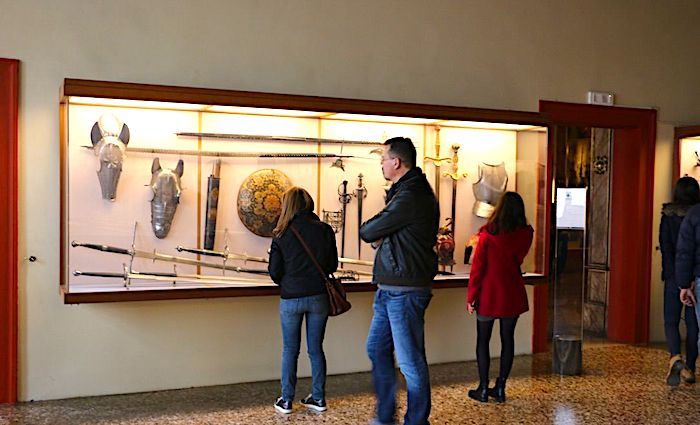

As the name implies, these four rooms house various weapons used throughout the centuries. Back in the day, this was where they stored all the weapons to be used by Venetian soldiers in times of war.
In room one, you’ll find a beautiful armor that belonged to the famous mercenary Erasmo da Narni, aka il Gattamelata. In the late Middle Ages and throughout the Renaissance, various famous mercenaries, called condottieri in Italian, were often saviors for various states. This was because they could come in with their own army and destroy your enemies…for a hefty price of course.
While there are many suits of armor in this room, one curiosity sticks out as it is a miniature suit of armor found on the battlefield in Marignano in 1515. It would have belonged to either a child or a dwarf.
Overall, you’ll find over 2,000 pieces in the exhibition including 15th and 16th-century suits of armor, swords, halberds, quivers, and crossbows. They also house armor and weapons of Turkish origin, which were taken during the wars against the Turks.
2. Museo Dell’Opera
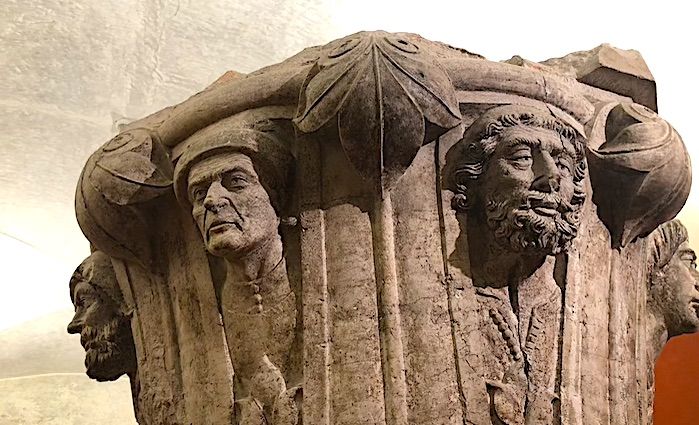

Over the ages, the Doge’s Palace was constantly under renovation or being rebuilt. This was due to various factors like the many fires that broke out and destroyed the building or the need to expand as the republic grew.
Starting back in the Middle Ages, there was a sort of technical office in charge of the maintenance of the palace. This office was called the Opera. In the mid-19th century, the palace was in such a state of disrepair that many wondered if it would survive.
In 1876, they began a restoration plan that would involve a huge overhaul of the building. Many pieces of artwork found during this period were set aside and are now preserved in the museum or Museo dell’ Opera. Over 42 of these capitals, which were in a bad state, were removed and replaced with copies. The originals have now been moved to the museum.
The medieval palace would have been richly decorated with columns and capitals. They depicted many stories and allegories in a format that would have been better understood by people of the time. These stories were like epic poems depicting men, women, animals, plants, zodiac signs, myths, symbols, vices, and virtues. It’s important to remember that literacy was reserved for the upper classes, so telling powerful stories through art was the best way for the general public to enjoy them.
1. Golden Staircase
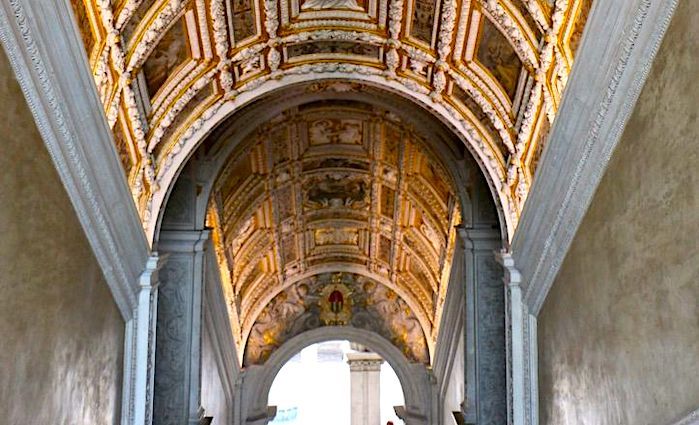

The doge’s apartments only occupied one of the three floors of the palace. However, to reach them, you would have to take the magnificent Golden Staircase or Scala d’Oro. The reason for this name is the ornately decorated stucco vault in gold overhead the staircase.
The architect of these stairs was none other than Jacopo Sansovino who also built the Scala dei Giganti (see number 9 above). It took him four years to build and was decorated by various artists such as Tiziano Aspetti, Alessandro Vittoria, Giovanni Battista Franco, and Francesco Segala.
Jacopo Sansovino, who is actually from Florence, found much success in both Florence and Rome. Supposedly, he submitted a design for the facade of San Lorenzo in Florence, but it was rejected by Michelangelo who was in charge of the overall scheme. Sansovino wrote a bitter letter of protest to Michelangelo, but to no avail.
He moved to Venice in 1529 from Rome as the famous sack of Rome began. In Venice, he was named chief architect to the procurators of San Marco. This was a huge honor and gave him a say in pretty much all of the projects in the city. He died in Venice and is buried in St. Mark’s Basilica.
Not ready to book a tour? Check out our article on the best Venice tours to take and why.
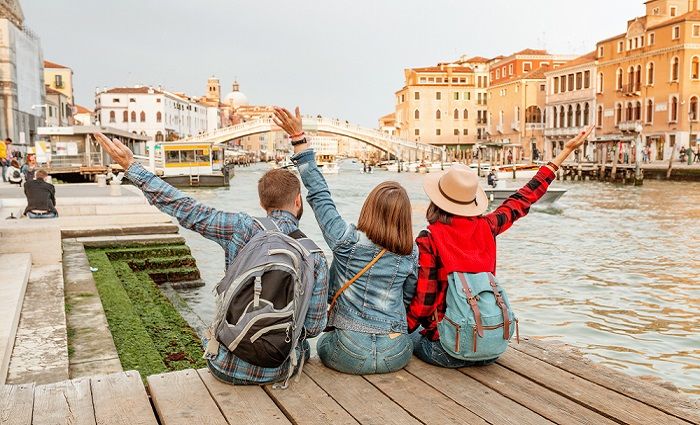

Where To Stay in Venice
Despite the size of this little island, there are endless hotel options to choose from. We’ve picked the best neighborhoods and hotels to stay in whether you prefer Italian luxury or quiet serenity—or both!

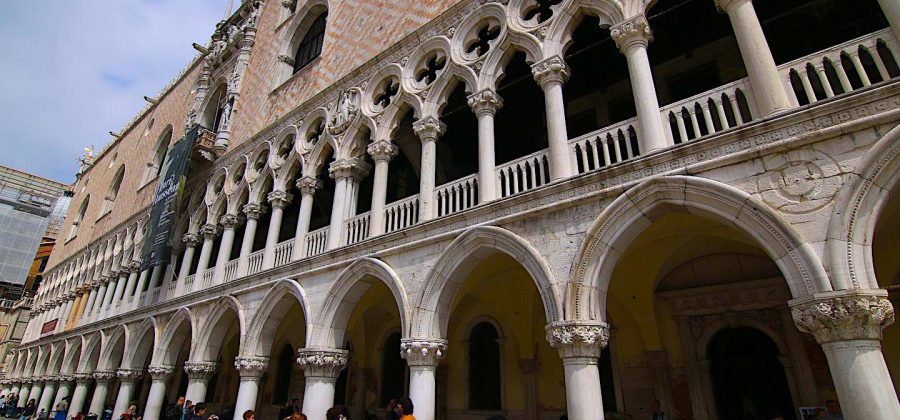
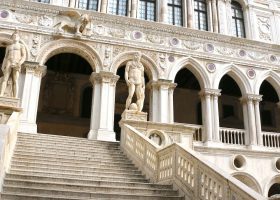
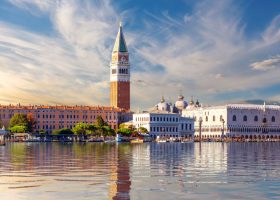
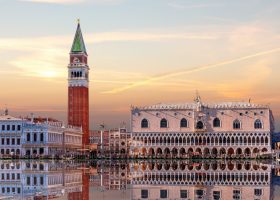

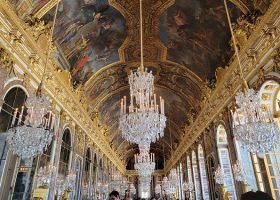
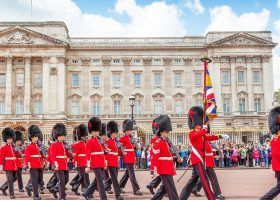


Leave a Comment